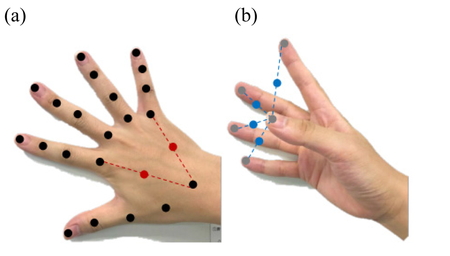2022 Volume 21 Issue 2 Pages 43-44
2022 Volume 21 Issue 2 Pages 43-44
An application for molecular dynamics (MD) simulations was implemented on a smartphone for utilizing virtual reality (VR) in chemistry education. This application consists only of a smartphone, a simple VR lens, and an on-board camera. The screen displays molecular motions equivalent to MD calculations in actual research. The molecules move synchronously with the six-dimensional movements of the user's head. The on-board camera also recognizes hand coordinates, allowing the user to "touch" and "grab" the molecules through the hand model displayed in the VR space. This application enables users to intuitively understand molecular motion. A special lecture was held at high schools using this application, and survey results shows that students' understanding of molecules improved.
An application for molecular dynamics (MD) simulations was implemented on a smartphone for utilizing virtual reality (VR) in chemistry education. This application consists only of a smartphone, a simple VR lens, and an on-board camera. The screen displays molecular motions equivalent to MD calculations in actual research. The molecules move synchronously with the six-dimensional movements of the user's head. The on-board camera also recognizes hand coordinates, allowing the user to "touch" and "grab" the molecules through the hand model displayed in the VR space. This application enables users to intuitively understand molecular motion. A special lecture was held at high schools using this application, and survey results shows that students' understanding of molecules improved.
近年の VR 技術の発展を受け,教育現場における VR 利用も期待されている [1, 2]. 特に三次元構造の理解に向けた応用が顕著であり,分子の立体構造の理解が必要な化学分野でもツール開発が進んでいる [3,4,5]. VR 上で MD 計算をリアルタイムに実施し,ハンドトラッキングで分子に触れる interactive MD (iMD)システムも構築されており [6, 7],大学の授業でも取り入れられている [8].
iMD システムを授業に取り入れる際に表示装置の調達コストは大きな問題となる.特に MD 計算を実施する場合,分子の動きとハンドトラッキングの時差を小さくするため計算機クラスターとの近距離通信が不可欠となり,専用の実習室が必要となる.装置の習熟コストも大きく,過去の実施例でも各学生が専属のアシスタントの下 10 分程度の実習を実施するにとどまっている [8].
VR 教材の実利用を考えると 30 人規模の教室での一斉利用が望ましく,現実的なハードウェアはスマートフォンに VR レンズを取り付けた簡易装置となる.これは大きな制約だが,MD 計算のフレームレートは動画表示レートに比べて十分に短く,粒子数を限れば実施可能と考えられる. そこで本研究では,スマートフォン上に MD 計算プログラムを直接実装し,スマートフォンのカメラを用いたハンドトラッキングシステムと連携することで簡易な iMD システムの構築を試みた [9].さらに構築システムを用いて 30 人規模の高校の模擬授業で使用し VR 装置の教育利用の実証も試みた.
iPhone 7 上に GAFF 力場 [10] を用いた MD 計算プログラムを実装した.分子と VR 画面上に表示される手モデルの引力点,斥力点(Figure 1)との間に簡易な相互作用を設定し,VR 上で分子に触れたり,掴んだりできるシステムを構築した(Figure 2).温度制御も実装し,VR 空間内に配置したスライドバーを動かすことで温度パラメータをリアルタイムに制御できるようにした.

Interaction points on the hand model. (a) attraction points (black and red), (b) repulsion points (blue). The black and gray points are obtained from the hand tracking system [12]. The red and blue points are calculated as the mid points between the edge points on each dotted line.

Example of a water cluster. Each water molecule can be grabbed by the black hand model.
高校で実施した出張講義では水素結合やファンデルワールス力などの非結合性相互作用を主題とした.具体的には核酸分子の水素結合の観察,水クラスターの温度変化の観察,分子ベアリング [11] の強いファンデルワールス力の体験の 3 つを VR 装置で体験してもらった.授業はスマートフォンの放熱のため体験の合間に講義を入れつつ 60 分の授業として実施した.全体としては 20 分程度の時間を VR 体験とし,残りは装置の説明と関連する基礎化学や先端研究の紹介とした.学生は 32 人,簡易 VR 装置は一人一台を貸し出した.アシスタントは 6 名配置したが,初期に補助に入った以外は学生主導で体験が進んだ.授業後のアンケートは概ね満足度の高い結果でハンドトラッキングの満足度が多少低めだった.今後トラッキング機能の改善により,満足度の向上が期待できる.
出張講義の実施では東京都立武蔵高等学校にご協力を頂いた.またアプリケーションの一部はインターンシップの実習として東京大学の児玉大樹さんに実装いただいた.